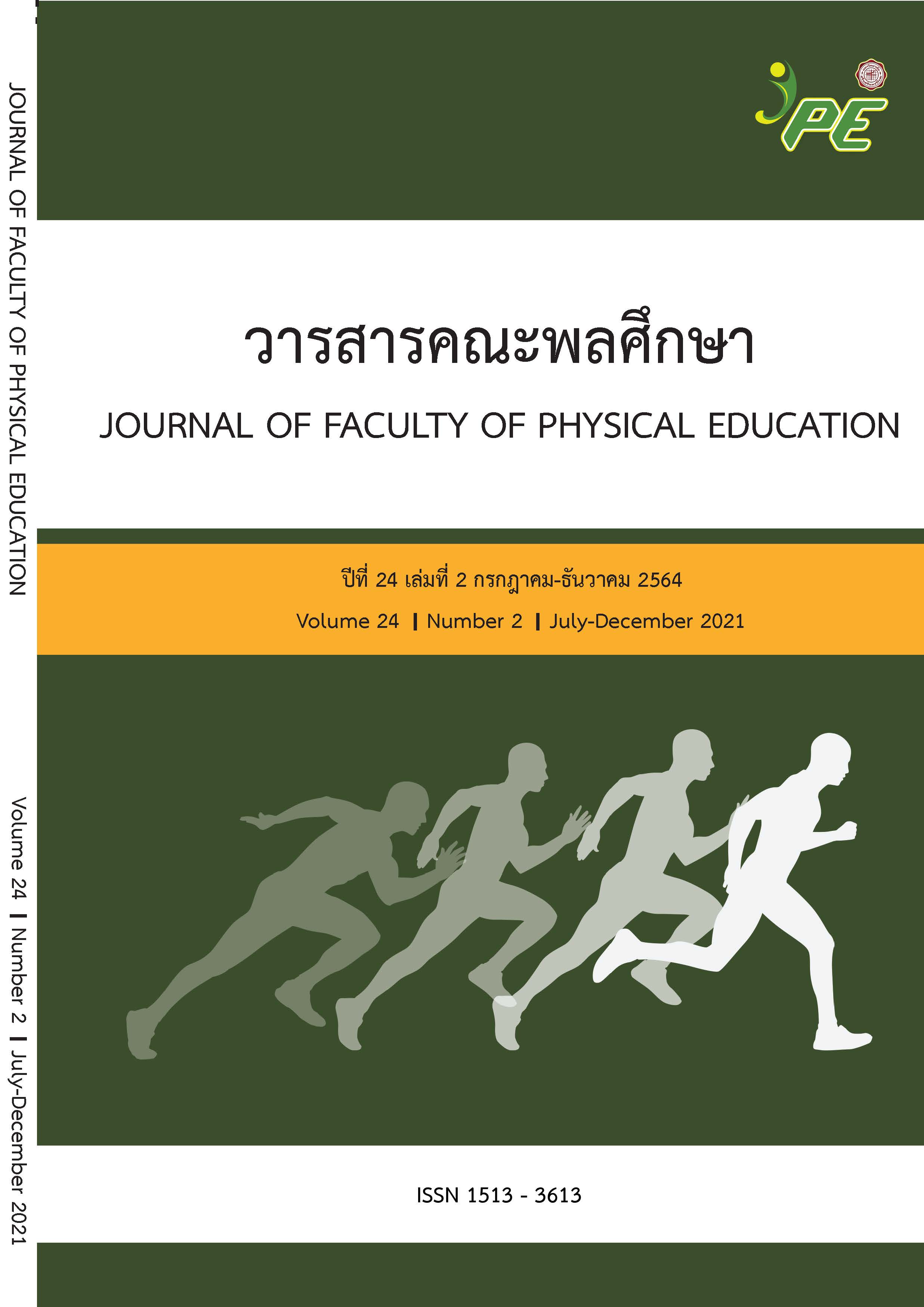การวิเคราะห์คิเนเมติกส์ของการกระโดดและผลเฉียบพลันของการฝึกการรับรู้มุมของข้อต่อ ในการกระโดดที่มีต่อแรงสูงสุด พลังสูงสุดและความสามารถในการกระโดด
Main Article Content
บทคัดย่อ
วัตถุประสงค์: เพื่อศึกษาและเปรียบเทียบผลเฉียบพลันก่อนและหลังการฝึกการรับรู้มุมของข้อต่อในการกระโดดที่
มีต่อพลัง แรงสูงสุดและความสามารถในการกระโดด
วิธีดำเนินการ: อาสาสมัครเป็นนักกีฬา 30 คน แบ่งเป็นกลุ่มควบคุมและกลุ่มทดลอง กลุ่มละ 15 คน เก็บข้อมูลทาง
กายภาพและทดสอบความสามารถในการกระโดดก่อนการทดลอง โดยทดสอบความสามารถในการกระโดด ได้แก่
ความสูง แรงสูงสุดและพลังโดยใช้แผ่นวัดแรงกระโดด Kinematics measurement system ส่วนมุมข้อต่อทดสอบ
ด้วยชุดวิเคราะห์การเคลื่อนไหวของ Simi Aktisys 2D เว้นระยะเวลาห่างกัน 7 วัน ทำการทดสอบความสามารถใน
การกระโดดโดยไม่จำกัดมุมเข่ากับกลุ่มควบคุม และทดสอบความสามารถในการกระโดดโดยจำกัดมุมเข่าที่
90 องศากับกลุ่มทดลอง จากนั้นให้กลุ่มทดลองฝึกการรับรู้มุมข้อต่อในการกระโดดที่จำกัดมุมเข่า 90 องศา
แล้วทดสอบความสามารถในการกระโดดที่จำกัดมุมเข่า 90 องศากับกลุ่มทดลองอีกครั้ง วิเคราะห์ข้อมูลด้วย
โปรแกรมสำเร็จรูป หาค่าเฉลี่ยและส่วนเบี่ยงเบนมาตรฐาน ทำการเปรียบเทียบความแตกต่างในกลุ่มโดยใช้การ
วิเคราะห์ความแปรปรวนทางเดียวชนิดวัดซ้ำและเปรียบเทียบภายหลังเป็นรายคู่โดยใช้บอนเฟอโรนี่ และ
เปรียบเทียบระหว่างกลุ่มโดยใช้ค่า “ที” กำหนดระดับนัยสำคัญที่ .05
ผลการวิจัย: เมื่อเปรียบเทียบภายในกลุ่มทดลองพบว่า ความสามารถในการกระโดด (แรงสูงสุด พลังสูงสุดและ
ความสูงในการกระโดด) ก่อนและหลังการฝึกการรับรู้มุมข้อต่อในการกระโดด แตกต่างกันอย่างมีนัยสำคัญที่ .05
แต่เมื่อเปรียบเทียบระหว่างกลุ่มควบคุมและทดลองพบว่าความสามารถในการกระโดดไม่แตกต่างกัน
สรุปผล: การฝึกการรับรู้มุมข้อต่อในการกระโดดมีผลต่อความสามารถในการกระโดด แต่เมื่อเปรียบเทียบผลการ
ฝึกกับกลุ่มควบคุมพบว่าความสามารถในการกระโดดไม่แตกต่างกัน
Article Details

This work is licensed under a Creative Commons Attribution-NonCommercial-NoDerivatives 4.0 International License.
บทความและข้อคิดเห็นใดๆ ในวารสาร เป็นทัศนะของผู้เขียน คณะพลศึกษาไม่จำเป็นต้องเห็นชอบด้วยเสมอไปผู้ใดประสงค์จะนำข้อความไปตีพิมพ์หรือเผยแพร่ต้องได้รับอนุญาตจากผู้เขียนโดยตรง
References
(1) Thailand National Sports University, Ministry of Tourism and Sports. Thailand National Sports
University Strategy 2018–2022 (Review Edition) Fiscal year B.E. 2563. Chonburi: Thailand
National Sports University.
(2) Tongdecharoen O. editor. Report of Elite Sport Center Physical Fitness Test. Monthly Meeting. 2018
Sep 30; Elite Sport Center. Si Sa Ket. Thailand Nation Sport University, Si Sa Ket Campus; 2019.
(3) Krabuanrat J. Science of Coaching. Bangkok: Sintana Copy Center CO.,LTD. 2557.
(4) Riansoi Y. The Effects of Combined Plyometric and Proprioceptive Neuromuscular Facilitation
Training on Legs Muscular Power. Journal of Sports Science and Health. 2016; 17(2): 43-55.
(5) Hill A R, Daniel L L, Soon-M C. The Acute Effects of Different Squat Intensities on Vertical Jump
Performance. International Journal of Exercise Science. 2019; 2(11): Article 32.
(6) Warren B Y. Transfer of Strength and Power Training to Sports Performance. International
Journal of Sports Physiology and Performance, 2006; 1(2): 74-83.
(7) Warren B Y, Brian D, Greg J. H. Agility and Change-of-Direction Speed are Independent Skills:
Implications for Training for Agility in Invasion Sports. International Journal of Sports Science & Coaching.
; 10(1): 159-169.
(8) Subhashish K S. Kinematic and Kinetic Analysis of Squat Jump and Counter-movement Jump. Thesis
Bachelor of Technology in Biomedical Engineering. India: Rourkela, Odisha; 2015.
(9) Wagner T M, von Duvillard S P. Mueller E. Kinematic Analysis of Volleyball Spike Jump. International
Journal Sports Medicine. 2009; 30(10): 760-765.
(10) Rahmani A, Dalleau G, Viale F, Hautier C A & Lacour J-R. Validity and Reliability of a kinematic
Device for Measuring the Force Developed During Squatting. Journal of Applied Biomechanics.
Conference of the International Society of Biomechanics in Sports, Cologne, Germany, 2000; 16, 26-35.
(11) Frühschütz H, Becker L, Russ P. & Spitzenpfeil P. Evaluation of Silhouette-Based Markerless
Tracking for Kinematics in Sport. International Society of Biomechanics in Sports. 2017; 35(1): 231.
(12) Cohen J. Statistical power analysis for the behavioral sciences. 2nd ed. Hillsdale, NJ: Lawrence
Erlbaum Associates, Publishers; 1988.
(13) Laffaye G, Wagner P, Tombleson T. Countermovement Jump Height: Gender and Sport-Specific
Differences in The Force-Time Variables. The Journal of Strength and Conditioning Research. 2014;
(4). 1096-1105.
(14) Newton R U. Kraemer W J, Developing Explosive Muscular Power Implications for a Mixed Methods
Training Strategy. Strength and Conditioning Journal. 1994; 16(5): 20-31.
(15) Nobre T L, et al .The Use of Proprioceptive Neuromuscular Facilitation for Increasing Throwing
Performance. Rev Bras Med Esporte.2020; 26(4): 332-336.
(16) Daehan Kim, Guido Van Ryssegem and Junggi Hong .Overcoming the Myth of Proprioceptive
Training. Clinical Kinesiology.2011; 65(1): Spring, 18-28.
(17) Baroni B M, Rodrigues R, Franke R A, Geremia J M, Rassier D E, Vaz M A. Time Course of
Neuromuscular Adaptations to Knee Extensor Eccentric Training. International Journal of Sports Medicine.
; 34(10): 904–911.
(18) Romero-Franco N, Martínez-López E, Lomas- Vega R, Hita-Contreras F & Martínez- Amat A.
Effects of proprioceptive training program on core stability and center of gravity control in
sprinters. The Journal of Strength & Conditioning Research, 2012; 26(8): 2071-2077.
(19) Aman J E, Elangovan N, Yeh I-L & Konczak J. The effectiveness of proprioceptive training for
improving motor function: a systematic review. Frontiers in Human Neuroscience. 2015; 8(1075) 1-18.

